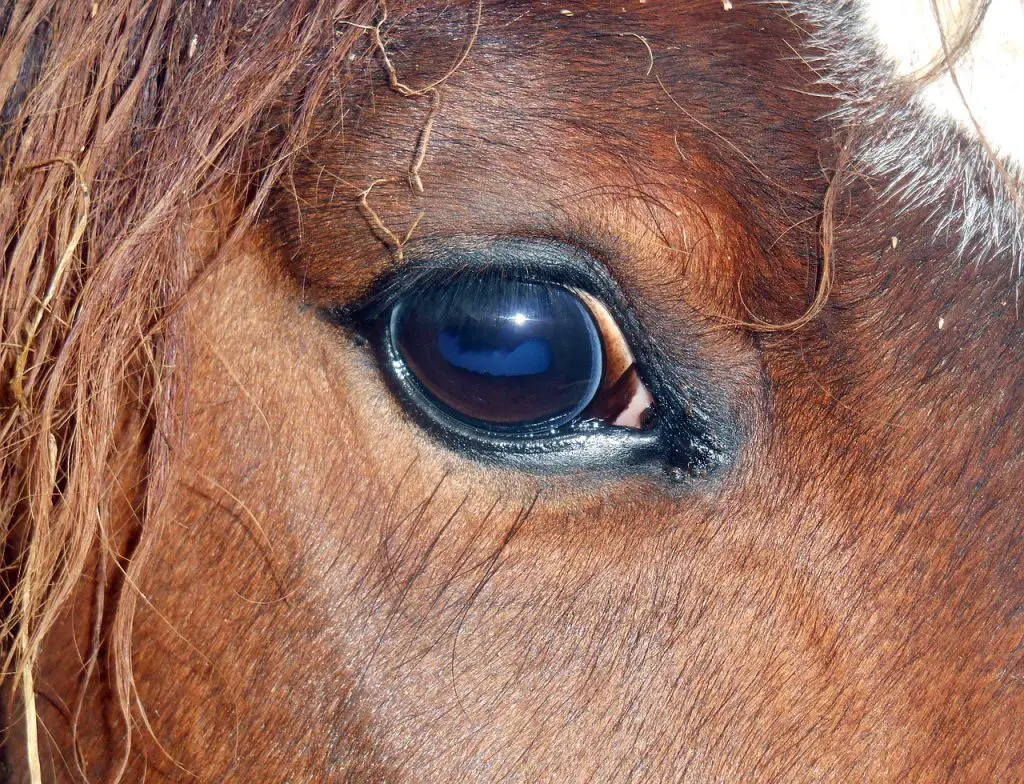Last Updated on March 18, 2022 by Allison Price
What is UVEITIS and what causes it?
Uveitis is an inflammation of the uveal system of the eye. The iris, ciliary body, and choroid make up the uveal system. These structures are the vascular (blood vessel), and pigmented.
Uveitis can be caused from
- Ocular trauma
- Viral or systemic infection
- Lens proteins are lost from a cataract.
- Ocular tumors
- Immune-mediated diseases
What is Equin Recurrent Uveitis?
Equine Recurrent Uveitis, also known as Equine Recurrent Uveitis, is a chronic, recurrent type of uveitis.
- “Moon blindness”
- Periodic ophthalmia
- Iridocyclitis
It is not clear what causes horses to have a recurring form of uveitis while others only experience a single episode. The repeated bouts of inflammation, if not treated promptly, can lead to permanent scarring and even blindness. ERU is the leading cause of blindness in horses. Recurrent episodes of inflammation may occur in either one or both eyes. Although it is impossible to predict when an episode might recur or how likely it will be, some owners report seasonal patterns or an increased chance of episodes around deworming or vaccination. Your veterinarian will be able to assist you in adjusting your preventative care plan to reduce the chance of a flare-up.

SIGNS OF UVEITIS
- You may notice these signs as a sign of uveitis:
- Eye redness and swelling
- Tearing
- Squinting and sensitivity to light
- Cloudiness or blue-ish cloudiness to the cornea
These are the first signs owners notice when the disease is beginning. Uveitis symptoms can look very similar to other eye conditions. It is important to speak with your veterinarian if you have any concerns about your horse’s eyes. Sometimes, it is necessary for the veterinarian to sedate your horse and numb your eyelids to properly examine your eye. Although they may look similar, treatment of uveitis can be very different from treatment for other eye conditions like corneal ulceration.
DIAGNOSIS:
Based on an ophthalmic exam, your vet can diagnose uveitis. ERU can be diagnosed if there are more than two episodes of uveitis. You can observe some of the more severe changes in an eye that isn’t actively inflamed. A thorough ophthalmic examination is an essential part of a prepurchase exam.
TREATMENT OF A SINGLE UVEITIS BOUT:
The treatment of uveitis involves a combination systemic and topical antiinflammatory medication. Bute and Banamine are non-steroidal antiinflammatory drugs that have pain relieving properties. Banamine is more effective than Bute or aspirin. A topical steroid solution or ointment is often used in the treatment of uveitis. This usually includes an antibiotic and a steroid cream. Topical application of steroids allows for high levels of medication to be delivered to the eye. Steroids have a stronger anti-inflammatory effect. A corneal ulcer is a reason to avoid topical steroids. If your veterinarian has diagnosed a corneal ulcer, you should not use a topical steroid. You can also apply topically a medication called atropine. The medication relaxes the muscles in the pupil, dilation occurs. You can also protect your horse’s eyes against light, irritants, and trauma by keeping them in a darkened stall or arena. After applying the atropine, you should be careful not to rub your eyes. The atropine may cause temporary, but unpleasant, dilation of your pupil. You’ve probably experienced a complete eye exam by a human optometrist.
TREATMENT OF RECURRENT UVEITIS
Patients with ERU experience active bouts of inflammation. To minimize inflammation and prevent permanent damage to the eyes, they are treated in the same manner as the previous paragraphs. Bute and other supplements like MSM, have not been shown to be effective in decreasing or preventing recurring episodes. Some veterinarian ophthalmologists recommend that daily aspirin be taken. Although it is not clear why, there is evidence to suggest that aspirin may reduce recurrence. The effectiveness of surgical implantation of a device that delivers powerful immunosuppressive drugs called cyclosporine A has been shown to decrease the severity and duration of inflammation as well as tissue damage in the eyes over a 3-to 4-year period. Horses with active inflammation that is not controlled by NSAIDs or topical steroids will not respond to treatment with cyclosporine.
It is important to be alert for subtle signs that a recurring bout may be coming on. If you are concerned that an episode may be starting, contact your veterinarian immediately.


